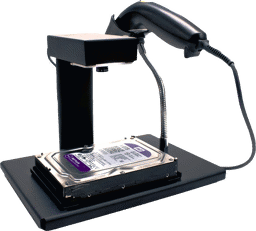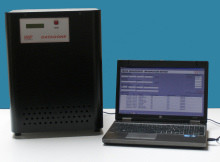Degausser / Erasers
1-24 of 40
DataGauss MAX - HDD Eraser
The DataGauss LG is hard disk data sanitization solution to easily and securely erase all data from hard disk drives or magnetic tapes using the degaussing method.
| SKU | VSDATGM |
* Prices excl. VAT, plus shipping
DataGauss XL-LG - Degausser for Hard drives
A degausser for hard disks with extra large arc chamber and LOG software for PC.
| SKU | VSDATG-LG-XL |
* Prices excl. VAT, plus shipping
DATAGONE LG - Safely destroy hard disks
Eraser with LOG software to safely destroy hard drives. (PC)
| SKU | VSDATAGON-LG-PLUS |
* Prices excl. VAT, plus shipping
VS Security Systems
V94 Universal Degausser
The V94 was specially developed for low deleting requirements.
| SKU | VS-V94 |
* Prices excl. VAT, plus shipping
VS Security Systems
V880 - Secure files erase
Extinguisher for the efficient deletion of files
| SKU | VS-V880 |
* Prices excl. VAT, plus shipping
intimus
intimus Hammer SE - Secure Erase
Data erasure on hard drives - Secure Erase
| SKU | INT-H-SE |
* Prices excl. VAT, plus shipping
VS Security Systems
Extinguisher, delete data, model SV 5000
Deletes all metal and Oxydbänder ... including 1 "coils
| SKU | SV5000 |
* Prices excl. VAT, plus shipping
Media-Clone
SuperWiper 7" Mini Field Secure Data Eraser unit - Linux
The SuperWiper™ 7" Mini unit with 3 SATA ports and 4 USB3.0 ports, very compact and very fast. It is a perfect mobile data erase tool, and it supports DoD, and Security Erase protocols. The unit can operates with external batteries.
| SKU | MC-SWM |
* Prices excl. VAT, plus shipping
SuperWiper Desktop Multi Channel Eraser Pro with S.M.A.R.T. testing
SuperWiper Desktop data Erase and Format 8 SAS/SATA drives and 6 USB3.0 Storage Devices, in extremely fast and most efficient operation.
A multiple channel hard drive eraser unit.
| SKU | MC-SWD |
* Prices excl. VAT, plus shipping
Media-Clone
SuperWiper 8" Erase SAS/SATA and USB3.0 - Erase 10 Storage Devices /Linux
SuperWiper 8" SAS/SATA Erase Field unit with SAS/SATA-3 and USB3.0 ports. Top performance of erase and wipe data from HDD, SSD, and USB storage devices.
| SKU | MC-SW8 |
* Prices excl. VAT, plus shipping
Media-Clone
SuperWiper 8" Erase SAS/SATA and USB3.0 i7 edition- Erase 10 Storage Devices /Linux
SuperWiper 8" SAS/SATA Erase Field unit with SAS/SATA-3 and USB3.0 ports. Top performance of erase and wipe data from HDD, SSD, and USB storage devices.
| SKU | MC-SW8i7 |
* Prices excl. VAT, plus shipping
VS Security Systems
V100 Bulk Eraser
The V100 is a continuous duty high energy degausser
| SKU | VS-V100 |
* Prices excl. VAT, plus shipping
VS Security Systems
Erasure Labels
Self adhesive red with black writing - to be used to identify that hard drives have been Degaussed.
* Prices excl. VAT, plus shipping
VS Security Systems
V660 - Harddisk Degausser
for easy securely deleting of harddisks
| SKU | V660 |
* Prices excl. VAT, plus shipping
VS Security Systems
V91 Max HDD and Tape Degausser
The manual V91 HDD Max degausser is a powerful second-generation degausser, specifically designed for the complete data erasure of hard drives and backup tapes. With a strong magnetic field of 7000 Gauss, it erases data in just 12 seconds per medium. This cost-effective device is ideal for operators with low volumes who need a reliable solution for secure degaussing and data destruction.
| SKU | VS-V91MAX |
* Prices excl. VAT, plus shipping
VS Security Systems
SV91M - Degausser for Cassettes and Hard Drives
The Verity Systems SV91M Degausser is a low-noise, manually operated high-performance degausser. It erases cassettes in 12 seconds and hard drives in three minutes, suitable for DLT, DAT, and PC hard drives. With 7,000 Gauss and a throughput of 20 hard drives or 40 tapes per hour, it provides a cost-effective degaussing solution.
| SKU | VS-SV91M |
* Prices excl. VAT, plus shipping
ADR Ingenieurprodukte
SAS/SATA Eraser with 4 ports
With SMART-Info, Touchscreen & 30 GB/Min Wiping Speed
| SKU | ADR-HDPRO4 |
* Prices excl. VAT, plus shipping
ADR Ingenieurprodukte
SAS/SATA Eraser with 16 ports
With SMART-Info, Touchscreen & 30 GB/Min Wiping Speed
| SKU | ADR-HDPRO16 |
* Prices excl. VAT, plus shipping
ADR Ingenieurprodukte
M.2 Eraser with 6 Ports
Standalone Data Sanitizer with Touchscreen, SMART-Info & 6 Ports
| SKU | ADR-HDPRO6M2 |
* Prices excl. VAT, plus shipping
ADR Ingenieurprodukte
SAS/SATA Hard Drive Data Eraser with 8 Targets
ADR Secure Data Eraser ensures secure and easy data removal with a one-time investment — no software or licenses needed. It's ISO compliant, protecting enterprise information security and supporting various storage media for up to 8 devices.
| SKU | ADR-HDPRO8SAS |
* Prices excl. VAT, plus shipping
































